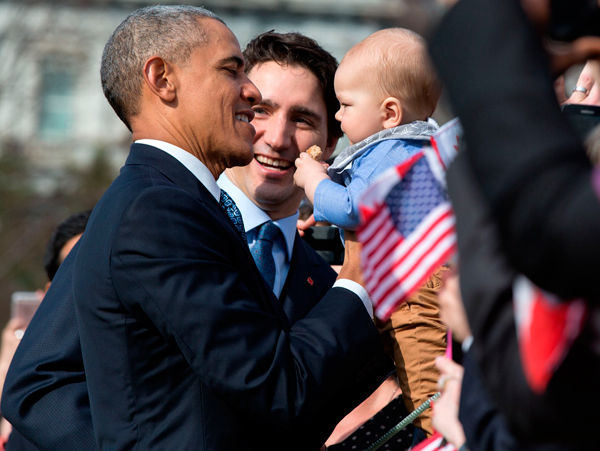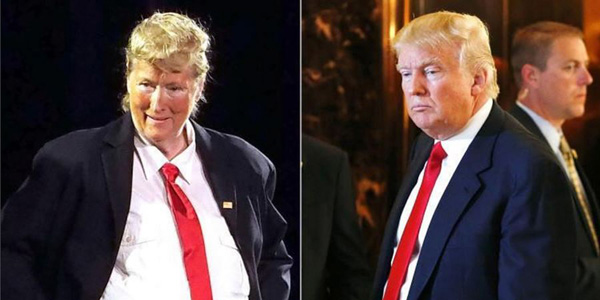What Brands Can Learn From Political Campaigns
The races for 10 Downing Street and the White House highlight universal lessons in brand strategy for keen observers. As a brand, there’s none more emotive and powerful than a prime minister or president of the United States.
The time period available in politics for building a party platform, selecting leaders, and creating a campaign is much shorter, and consequently more intense, compared to all other arenas of brand building.
Nonetheless, just like the smallest of brands, the candidates must build that essential emotional bond whether through shaking hands, kissing babies or connecting with consumers at every single touchpoint in a way that’s relevant to them to earn every single vote. As students of brand marketing, the highly focused, condensed time frame and intense process of building a brand to attract voters — similarly to gaining customers — is rich in takeaways for businesses of any size.

US President Barack Obama and Prime Minister Justin Trudeau – (Public Domain)
Brand Vision: Differentiation is Everything in Brand Strategy
How many times have you heard someone say, “I’m not voting…all politicians are the same.” Political campaigns remind us that clear brand differentiation is key if you are to capture your audience’s attention, imagination and support. In politics that vision is policy; in branding that vision can be whatever you choose…as long as it’s undeniably clear, relevant to your primary audience and expressed in easy to understand language that resonates with them.

Image via hillaryclinton.com
Explain your brand vision. Paint a picture of what the world could look like and how others can be part of that when they buy into the vision of your brand. This must be a really bright North Star that shines for your audience and attracts word-of-mouth referral time after time.
Listen as US President Franklin Delano Roosevelt delineates four essential human freedoms. FDR’s “Four Freedoms” speech leaves no question regarding the nation’s vision, “attainable in our own time and generation,” on the eve of US involvement in World War II.
Listen as John F. Kennedy takes just 30 seconds to articulate his vision in the 1961 inaugural address, speaking first to Americans and then to fellow citizens of the world.
Healthy Brand Competition
In sales training, we’re taught to emphasize benefits; trashing the competition is not the right approach. Some politicians are known to be terrible at this. Instead of articulating an optimistic vision, candidates often tell you how lousy the incumbent and/or the competition is. Arguably some consider Donald Trump to be the champion of insults — a skill he developed on reality television and honed in debates — which doesn’t always translate so well in real life.
To get out the vote, that political position must be communicated across all stakeholders: volunteer voter registration workers, doorbell ringers, call centres, college campus activists, hundreds of regional election headquarters, social media gurus, data experts, staffers, media and the public. To gain customers, that brand message must be reflected at every touchpoint and resonate with current buyers, prospective buyers, suppliers, vendors, distributors, every employee, shareholders, investors, and the CEO.
In the absence of articulating and sharing a compelling brand message, disinterest develops, or even cynicism and mistrust. In politics, this translates into divisiveness, fear, insecurity — and a landslide for the opposition. For a brand, it means that reputation suffers and sales decline.
You Are Your Brand
The brand called YOU is a multi-layered lesson we can learn (both good and bad practices) by watching the political stage during an election cycle. Certainly, public opinion can be influenced by the packaging: takeaways like Hillary Clinton’s pantsuits and Donald Trump’s unique hairstyle make an indelible mark, as with any brand.

Meryl Streep as Donald Trump – (@simply_the_best_ms on Instagram)
Also, brand marketers can observe how politicians use tone of voice, choice of words, truthfulness, authenticity, facts, listening skills, presentation style, distribution channels, frequency, inspirational metaphors, storytelling, consistency or lack of it, and more to make connections and grow audience. On occasion, they provide examples of what NOT to do.
Everyone involved has a chance to be a brand that is worthy of notice via its most important asset: People. Motivated, enthusiastic, hard working, smiling, clever and talented people make all the difference.
Know Your Brand’s Target Audience
Skills and insight go into knowing and understanding your target audience so you can speak their language, tap into their attitudes and values, and build a simple, strong compelling message that they find irresistible. That magnetism factor is a really important part of successful brand building. It’s one of the critical tools used for mapping out your different customer types in what we call Purchaser Personas.
In fact it’s one of the key elements in our brand building programme called the Personality Profile Performer™. You can’t attract the attention of your ideal audience and sustain their interest if you don’t know them intimately — their needs, wants, loves, hates and aspirations. Every business has a minimum of two and up to twenty different customer Purchaser Personas which provide the critical insights and direction for how your brand can speak to your customers — winning their hearts and minds on their terms — so you can grow your business.
The mechanisms of polling, precincts and predicting are complicated. We leave that to the experts. Nonetheless, you’ll hear news commentary about politicians of all political persuasions “appealing to their base” and/or “broadening the base.”
As in branding, the articulation of mission, values, and promise are essential. Communication with target audiences to understand their likes and dislikes is the first step, however talking to the base over and over doesn’t bring in a single new vote. Brand expansion while maintaining brand loyalty with a core audience is the name of the game in politics as in retailing and other customer verticals.
Brand Messaging Cannot be Overrated
The importance of driving powerful brand impact is what Donald Trump might call “H-U-U-U-G-E” because connecting at a deep emotional level moves people strategically and emotionally. The intensity of the brand message is what makes it stand out; the authenticity of the brand message is what makes it stick.
How you communicate with your audience and what message you bring is what keeps audiences loyal and strengthens bonds. As with any branding strategy, placement, delivery, frequency and tone of voice matter. It’s so easy to turn people off with too much noise and overexposure.
In America, where the election process rolls out over two years and intensifies as election day draws nearer, this skill must be managed and sustained over weeks and months, just like a brand must do in the broader marketplace.

Image via donaldjtrump.com
Brand Storytelling Matters
It is critical to stay true to your brand’s DNA and not get lost, unglued, or disconnected. We’re conditioned that way. When a child asks you to read their favourite bedtime story, they’re anticipating the same story with the same ending.
Politicians are famous for the brand disaster known as a flip-flop on issues, and it can cost an election or tank sales. Whether in the political arena or in branding, there’s simply no room for inconsistent storytelling. It kills believability and trust.
The big why behind the brand story challenges us to build stories that promote something for the greater good. With vision, we can create and communicate a loveable brand, or a sustainable brand, or a socially responsible brand, or a caring, charitable brand…just like building a personality that people will vote for.
Sub-Branding Opportunities and Risks
Sometimes brands create sub-brands to serve expansion goals, as in Coors and Coors Light or American Express and the American Express Gold and Platinum Card. The risk is that sub-brands can detract from core brands, using precious time, energy and resources. Secondly, the sub-brand reputation reflects on its parent brand; the overall customer message can become diluted or compromised.
To minimise or eliminate risks, we recommend taking professional branding advice if you’re considering sub-branding to avoid costly mistakes. Planning your brand structures in the form of new or additional related or unrelated products or services, also known as brand architecture, is a critical part of the strategic planning and brand building process. We’ve seen this play out recently on the political world stage. Brand expansion must be taken seriously to protect core brand values. However, adding Alaska Governor Sarah Palin to John McCain’s 2008 ticket diluted the brand.
When Hillary Clinton undertook a six-month vice presidential vetting process, the selection was received quite differently to when Britain’s new Prime Minister Theresa May selected dropout candidate Boris Johnson as foreign secretary in an overnight surprise. The former London mayor’s brand image is reportedly lacking in the required decorum associated with such an important role according to other world leaders.
“My chances of being PM are about as good as the chances of finding Elvis on Mars, or my being reincarnated as an olive.” – Boris Johnson [1]
The Appeal of Disruptor Brands
What did brand managers learn from Bernie Sanders during the 14-month lead up to the Democratic Convention, when the challenger was the Millennials’ poster boy, a lovable white-haired grandfather, small-town Vermont Senator?
- It takes time and resources — generally a year or so — for any challenger brand to successfully disrupt.
- A clearly and passionately articulated brand vision should be communicated over and over again.
- This candidate’s storytelling remained on message (since his youth), establishing strong authenticity, trust and delivering no surprises.
- Bernie Sanders successfully reached a broad audience through brand activation and personal engagement. While pre-imposed deadlines brought his campaign to an end, the branding strategy was successful.
- Watch what happens when a little bird lands on Bernie Sanders’ podium during a speech. The crowd goes crazy and the candidate turns the moment into an articulation of his vision, “No more wars.”
Consider these questions:
- Is your brand vision well developed and clearly communicated?
- Have you shared your brand vision with all stakeholders?
- Is your brand failing to connect and perhaps in need of a rebrand or brand refresh?
- Do you and your employees passionately personify your brand?
- Is your brand story clearly articulated across multiple customer touchpoints?
- Are you considering sub-branding as a strategy for brand expansion?
- Are you a brand challenger with a clear point of differentiation?
[1] http://www.telegraph.co.uk/news/politics/london-mayor-election/mayor-of-london/10909094/Boris-Johnsons-top-50-quotes.html











